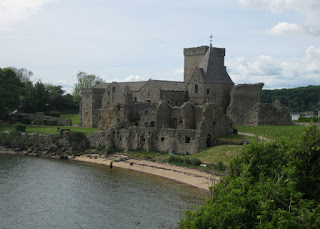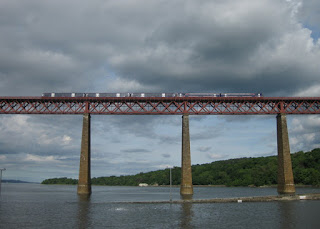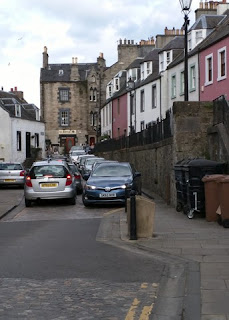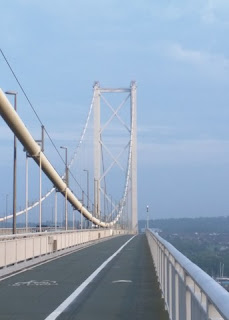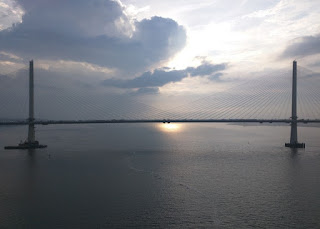What century is this? Oh yeah, the 21st century.
British Airways had a “power outage” yesterday, which somehow triggered an epic technology meltdown. All flights through London (both airports) were cancelled. The news reports showed tired, angry travelers packed like sardines—just trying to exit the terminal. Mountains of luggage. My itinerary, a day earlier, would have landed me in that morass. [I'm feeling lucky.]
This morning I woke to the expected news: my flight from Edinburgh to London had been cancelled. Contact the airline to re-book.
Called, and got a recorded message that said they weren't taking calls.
Their website was reduced to a plain-text message that said they're working on the problem.
This will be one heck of an expensive power outage. Upgrading their systems, or running hot spares, would have been less costly. (Just a hunch.)
I found myself a flight home (through Dublin), booked another night in the motel, and strolled into town.
There were people rappelling down from the Forth Bridge! I learned a new word: abseil.
Teams wore colorful t-shirts for the charitable cause they were supporting: Alzheimer's, hospice, cancer. This was a fund-raising event.
No dangling from a bridge for me. I boarded the Maid of the Forth, with a ticket to visit Inchcolm.
In addition to the remains of an abbey that dates back to the 12th century, there are military remnants from the island's role in defending the Forth during World Wars I and II.
It was possible to wander freely through the site, including climbing to the top of the tower. Which (of course) I had to do. Not just for the view, but because the treacherous route to the roof would never be permitted back home. [Never. “Someone could get hurt!”]
Before you reach the steep stairs, you must first squeeze up a tight, spiraling passage of shallow stone steps. No handrails. No margin for error. It actually was frightening—and thrilling. Keep in mind: what goes up, must come down ...
But oh, the views all around! The city of Edinburgh, the three bridges, open water leading to the North Sea. Not to mention a dizzying perspective on the cloister, below.
Back in the 13th century, of course, it would have been impossible for me to enter these chambers. Eight hundred years later, the plaster is gone but the walls and architectural details endure.
There is a large population of seagulls on the island, and they defend their ground-level nests fiercely. They nest also amidst the garden ornaments on “Inch Gnome,” a nearby bit of rock. One of the gnomes holds a fishing rod, its line dipping into the water.
Before returning to our berth, we navigated under the three bridges. A fellow traveler explained that the Forth Road Bridge is outfitted with sensors monitoring for the sound of those snapping strands of cable (12,000 strands, in all).
When it opens, the Queensferry Crossing will offload heavy traffic from the older bridge.
The bridges are high enough, and the channel deep enough, for a floating hotel (er, cruise ship) to sail through, to the sea.
The Forth Bridge is not just for abseiling ... it's a very busy rail link.
A “me first” attitude did not serve this driver well. A little courtesy, instead, would have served everyone well on the narrow main street in South Queensferry.
No problem for me, on foot, as I wrapped up my bonus day in the U.K.
May 28, 2017
May 27, 2017
The Firth of Forth
Accommodations in Edinburgh were scarce—and expensive—when I made plans for this trip. Turns out it's a “bank holiday” weekend, and on top of that there's a marathon in the city tomorrow.
I opted to stay in nearby South Queensferry, along the Firth of Forth.
I'd captured some photos of the famous bridges on Friday evening; now that I had my bearings, I decided to get a different perspective—from the deck of the Forth Road Bridge.
After the rain, the air was cool; I regretted not bringing a jacket. If it weren't so chilly, I would walk all the way across the span (to North Queensferry). If only I had a bicycle ...
Ah, well ... walk faster, stay warm.
I crossed to Fife on the west side of the bridge, with an unobstructed view of the Queensferry Crossing (under construction).
I thought I would walk back on the east side, with unobstructed views of the historic Forth Bridge, but the walkway on that side was closed. When it was constructed in the late 19th century, it was the longest cantilever bridge in the world. Still in full service, it also has the distinction of being a UNESCO World Heritage Site.
The younger Forth Road Bridge, a suspension design, has not fared so well. The deck of the bridge hangs from what look like a pair of giant cables. They're really housings that encase the bundle of actual cables, some of which are snapping inside—weakened by corrosion over the past 50-odd years.
The solution is to build yet a third bridge, the cable-stayed Queensferry Crossing, which is due to open later this year. In the eyes of modern beholders, it's a graceful design. Yet, I imagine the same was said of the other two bridges, when they first spanned the Forth.
The time approaches for me to take my leave of Scotland, to return home to the world of work.
I opted to stay in nearby South Queensferry, along the Firth of Forth.
I'd captured some photos of the famous bridges on Friday evening; now that I had my bearings, I decided to get a different perspective—from the deck of the Forth Road Bridge.
After the rain, the air was cool; I regretted not bringing a jacket. If it weren't so chilly, I would walk all the way across the span (to North Queensferry). If only I had a bicycle ...
Ah, well ... walk faster, stay warm.
I crossed to Fife on the west side of the bridge, with an unobstructed view of the Queensferry Crossing (under construction).
I thought I would walk back on the east side, with unobstructed views of the historic Forth Bridge, but the walkway on that side was closed. When it was constructed in the late 19th century, it was the longest cantilever bridge in the world. Still in full service, it also has the distinction of being a UNESCO World Heritage Site.
The younger Forth Road Bridge, a suspension design, has not fared so well. The deck of the bridge hangs from what look like a pair of giant cables. They're really housings that encase the bundle of actual cables, some of which are snapping inside—weakened by corrosion over the past 50-odd years.
The solution is to build yet a third bridge, the cable-stayed Queensferry Crossing, which is due to open later this year. In the eyes of modern beholders, it's a graceful design. Yet, I imagine the same was said of the other two bridges, when they first spanned the Forth.
The time approaches for me to take my leave of Scotland, to return home to the world of work.
Subscribe to:
Posts (Atom)



